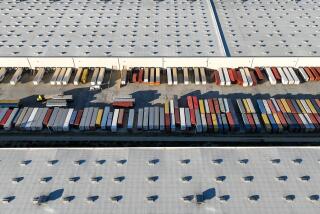Law to Cover Truckloads of Gravel Gets Airing : Safety: The statute aims to reduce windshield breakage, which costs drivers and insurers $60 million yearly.
As the angry wife of a truck-company owner heckled him, Assemblyman Richard Katz (D-Sylmar) Thursday touted a new law he authored to help protect motorists’ windshields from ricocheting gravel by requiring covers on rock-laden trucks.
The law, which took effect Sept. 1, requires truckers to place tarpaulins or other covers on loads of rocks, gravel and sand. Those with uncovered loads higher than the truck’s sideboards face citations from the California Highway Patrol.
But trucking industry representatives, who dropped their original opposition to the statute after negotiations with Katz, said its estimated $120-million cost ultimately will be borne by consumers.
Katz chose a noisy Sun Valley gravel pit for a news conference to discuss the law. As truckers rumbled back and forth, Katz displayed three windshields he said had been broken by rocks and gravel thrown off by trucks.
“Until now, driving anywhere near a gravel truck was like walking through a forest full of snipers--you never knew when you were going to get hit,” said Katz, who chairs the powerful Assembly Transportation Committee.
But with CHP enforcement of the new law, “the risky game of dodge ball on our freeways should be coming to an end,” he said.
The load-covering provision is the final phase of a 1989 law aimed at reducing the number of windshields broken by flying gravel, a problem Katz said costs California motorists and insurance companies up to $60 million annually.
The law’s other provisions, which took effect last year, require truckers to have lower mud flaps, higher sideboards and sealed dumping vents.
CHP Officer Mike Clarke said that under previous law, truckers cited for spilling gravel on the freeway faced a $130 fine. He said the new law imposes no stiffer penalties, but does allow officers to immediately cite truckers with uncovered loads rather than following them for miles until rocks actually fall off.
Katz also announced that the CHP has set up a hot line for motorists to make reports if their windshields are cracked by rocks or if they see a truck spewing gravel. The CHP will then tell motorists the address of the trucking firm, allowing them to call the company and seek reimbursement for the damage, he said.
The legislation was vigorously opposed by the trucking industry when it was introduced in 1985. Truckers argued that covering loads would be too costly and that the problem of broken windshields was grossly exaggerated.
But industry representatives dropped their opposition after realizing that the new measure will allow them to save money by sharply reducing the reimbursements they give motorists whose windshields are damaged, said Larry Farrens, executive vice president of the California Carriers Assn.
Many companies routinely reimburse motorists whose windshields are damaged by their vehicles. But with covers on the trucks, the industry feels that the number of such claims it will pay will drop off sharply, Farrens said.
James D. Martens, executive director of the California Dump Truck Owners Assn., complained that it will cost truckers $120 million to purchase tarpaulins and other coverings. But he noted that the cost of the law will be passed along to consumers.
The state Public Utilities Commission recently agreed to let gravel haulers raise their rates 1.2% to cover the expense of complying with the statute, Martens said.
“You can’t absorb these kinds of things and just continue,” he said. “This is technically a pretty marginal business anyway.”
At his news conference, Katz was briefly interrupted by heckling from Sammie Wagner, whose husband owns a small Sun Valley trucking company. Wagner angrily complained of the costs of the tarpaulin requirement.
Wagner said in an interview that it will take the average trucker about five years to recoup the cost of the tarpaulins, which sell for about $3,700 each, under the PUC formula.
Wagner said the covers are unnecessary, since most of the gravel that flies off a truck comes from its tire treads.
“I think it’s absolutely a waste of money,” she said. “It’s coming through the treads, and there’s no way you’re going to be able to stop it.”
But Katz said covers will help keep gravel out of truck treads by keeping it off the road in the first place.
More to Read
Get the L.A. Times Politics newsletter
Deeply reported insights into legislation, politics and policy from Sacramento, Washington and beyond. In your inbox three times per week.
You may occasionally receive promotional content from the Los Angeles Times.










